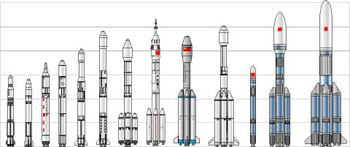Source: astronautix.com
10-21-2007 09:18
 |
The black powder rocket was invented by the ancient Chinese, but no indigenous effort in development of rocketry or space theory took place until the return of Tsien Hsue-Shen to China from America in 1955. Tsien was one of the legendary Theodor von Karman and the leading theoretician in rocket and high-speed flight theory in the United States.
Building rocket technology in China was to be a long process. Achieving the indigenous technologies in metallurgy, machinery, and electronics was an enormous task. Tsien assisted in negotiation of a 1956 agreement with the Soviet Union for transfer of rocket and nuclear technology to China, including training of Chinese students at Russian universities.
The Russians provided an R-2 rocket, an improved version of the V-2, as a starting point. But in 1960 the Soviet government discontinued further co-operation with China. Nevertheless later that year Tsien launched the first Chinese-built R-2, the DF-1.
Chinese political upheavals - the Great Leap Forward, the Cultural Revolution, Tsien backing of the disgraced Lin Biao - further delayed progress. Nevertheless by 1971 China had completed development of its own IRBM (the DF-2) and tested its first ICBM (the DF-5).
The DF-3 IRBM was the basis for the CZ-1 space launch vehicle, while the DF-5 spawned a long series of CZ-2, CZ-3, and CZ-4 launch vehicles. By 1970, the CZ-1 had launched China's first satellite, making China the fifth spacefaring country in the world.
Following an early cancelled manned spaceflight project, China turned to development of more-modest unmanned spacecraft and entered the international commercial launch market in 1985. China developed new cryogenic engines and used a modular approach based on the CZ-2 design to create a family of 12 Long-March rocket configurations capable of placing up to 9,200 kg into orbit.
China launched 27 foreign-made satellites in 1985-2000. However then a US embargo over improper technology transfer and collapse of the MEO satellite market led to a sharp reduction in commercial launches. China established three land-locked launch sites to reach various orbits. These were Jiuquan, for launch to mid-inclination orbits, Xichang for launch to geosynchronous orbit, and Taiyuan for polar orbits.
In April 1992 the Chinese leadership decided that an independent manned space program could be afforded. New launch facilities were built at the Jiuquan launch site for the CZ-2F manned launch vehicle.
The project culminated in the launch of China's first astronaut in 2003. China's ten-year space objectives established in 2000 included development of a new generation of expendable launch vehicles using non-toxic, high-performance propellants with lower operating costs. Development of reusable launch vehicles remained a distant goal for the post-2015 period.
Editor:Yang Jie
